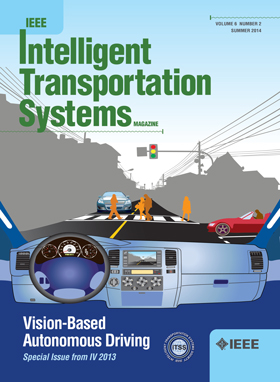Vehicle Longitudinal Stochastic Control for Connected and Automated Vehicle Platooning in Highway Systems
IF 8.4
1区 工程技术
Q1 ENGINEERING, CIVIL
IEEE Transactions on Intelligent Transportation Systems
Pub Date : 2025-06-09
DOI:10.1109/TITS.2025.3572555
引用次数: 0
Abstract
The vehicle platoon control for highway traffic can help to improve traffic flow efficiency, enhance traffic safety, and reduce fuel consumption. In previous platoon control research, most of the driving behaviors are described using deterministic car-following models. Nevertheless, random factors that may come from the vehicle power train and additional stimuli, can have a greater impact on platoon control in highway traffic. In this paper, a novel stochastic control method is proposed based on a stochastic car-following model which considers microscopic driving behavior. Firstly, the stochastic car-following model is designed that fully accounts for the impact of random factors on platoon control. Secondly, an optimal objective function is constructed and the Hamilton-Jacobi-Bellman equation is used to solve this stochastic control problem, thereby completing the upper-level controller design and obtaining the optimal desired acceleration of the vehicle. Thirdly, the stochastic stability method is applied to analyze the proposed model and obtain the stochastic stability conditions satisfied by the model. Finally, tests are conducted for three different scenarios: stable speed, acceleration, and deceleration with additive and multiplicative noise, as well as the case where the lead vehicle’s speed is based on real vehicle trajectory data. These tests validate the stability and effectiveness of the stochastic car-following model predictive control method from the perspective of control strategy and model respectively. The experimental results show that under the stable parameter conditions of the model, the connected and automated vehicle platoon can achieve accurate speed tracking and maintain an appropriate safe distance in highway system.高速公路系统互联自动车辆队列的车辆纵向随机控制
公路交通车辆排控制可以提高交通流效率,增强交通安全,降低燃油消耗。在以往的队列控制研究中,大多数驾驶行为都是用确定性的车辆跟随模型来描述的。然而,来自车辆动力系统和额外刺激的随机因素可能会对高速公路交通中的队列控制产生更大的影响。在考虑微观驾驶行为的随机跟车模型的基础上,提出了一种新的随机控制方法。首先,设计了充分考虑随机因素对队列控制影响的随机车辆跟随模型;其次,构造最优目标函数,利用Hamilton-Jacobi-Bellman方程求解该随机控制问题,从而完成上层控制器的设计,得到车辆的最优期望加速度;第三,运用随机稳定性方法对所提出的模型进行分析,得到模型所满足的随机稳定性条件。最后,在三种不同的情况下进行了测试:稳定速度、加性和乘性噪声下的加速和减速,以及领先车辆的速度基于真实车辆轨迹数据的情况。这些试验分别从控制策略和模型两方面验证了随机跟车模型预测控制方法的稳定性和有效性。实验结果表明,在模型参数稳定的条件下,联网自动化车辆排在公路系统中能够实现准确的速度跟踪并保持适当的安全距离。
本文章由计算机程序翻译,如有差异,请以英文原文为准。
求助全文
约1分钟内获得全文
求助全文
来源期刊

IEEE Transactions on Intelligent Transportation Systems
工程技术-工程:电子与电气
CiteScore
14.80
自引率
12.90%
发文量
1872
审稿时长
7.5 months
期刊介绍:
The theoretical, experimental and operational aspects of electrical and electronics engineering and information technologies as applied to Intelligent Transportation Systems (ITS). Intelligent Transportation Systems are defined as those systems utilizing synergistic technologies and systems engineering concepts to develop and improve transportation systems of all kinds. The scope of this interdisciplinary activity includes the promotion, consolidation and coordination of ITS technical activities among IEEE entities, and providing a focus for cooperative activities, both internally and externally.
 求助内容:
求助内容: 应助结果提醒方式:
应助结果提醒方式:


